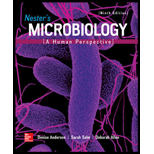
What is the purpose of rennin in cheese-making?
To review:
The purpose of renin in the making of cheese.
Introduction:
Microorganisms such as bacteria are widely used at commercial scale for the production of food. In the dairy industry, lactic acid bacteria (their end product is lactic acid) are employed in order to make fermented milk products such as yogurt, cheese, and buttermilk. These food products are consumed by the people all over the world as they taste good and are also rich in nutrients.
Explanation of Solution
Cheese is one of the fermented milk product, which is made by the addition of lactic acid bacteria. The pasteurized milk is inoculated and incubated for its fermentation and coagulation of the milk proteins. Rennin is an enzyme that is a protease and coagulates the proteins. It is added during the cheese production in order to increase the rate of coagulation of the milk proteins, such as casein. The whey milk protein is then removed by curdling from the coagulated proteins becauseit is not needed for the production of cheese.
Therefore, the role of renin in the making of cheese is to enhance the rate of coagulation of the milk proteins and separate the solid proteins from that of the liquid.
Want to see more full solutions like this?
Chapter 30 Solutions
Nester's Microbiology: A Human Perspective
- Anwser these Discussion Questions: Part One Why were the plants kept in the dark prior to the experiment? Why is this important? Why is it important to boil the leaf? Explain why it was necessary to use boiling alcohol? What is the purpose of the iodine? Part Two What was the purpose of keeping the leaf in the dark and then covering it with a cardboard cut-out? What conclusions can you draw from this part of the lab? Part Three 7. In this experiment what was the purpose of adding the soda lime? 8. Why was a sealed bag placed around each plant? 9. What happened in the control plants? 10. What was the result on photosynthesis? Part Four 11. Why was a variegated leaf used in this experiment? !2. What conclusions can you draw about starch production in a variegated leaf?arrow_forwardHow did the color differences between the two bacterial species you used in this experiment help you determine if the streak plate method you performed was successful?arrow_forwardseries of two-point crosses were carried out among six loci (a, b, c, d, e and f), producing the following recombination frequencies. According to the data below, the genes can be placed into how many different linkage groups? Loci a and b Percent Recombination 50 a and c 14 a and d 10 a and e 50 a and f 50 b and c 50 b and d 50 b and e 35 b and f 20 c and d 5 c and e 50 c and f 50 d and e 50 d and f 50 18 e and f Selected Answer: n6 Draw genetic maps for the linkage groups for the data in question #5. Please use the format given below to indicate the genetic distances. Z e.g. Linkage group 1=P____5 mu__Q____12 mu R 38 mu 5 Linkage group 2-X_____3 mu__Y_4 mu sanightarrow_forward
- What settings would being able to isolate individual bacteria colonies from a mixed bacterial culture be useful?arrow_forwardCan I get a handwritten answer please. I'm having a hard time understanding this process. Thanksarrow_forwardSay you get AATTGGCAATTGGCAATTGGCAATTGGCAATTGGCAATTGGCAATTGGC 3ʹ and it is cleaved with Mspl restriction enzyme - how do I find how many fragments?arrow_forward
- Which marker does this DNA 5ʹ AATTGGCAATTGGCAATTGGCAATTGGCAATTGGCAATTGGCAATTGGC 3ʹ show?arrow_forwardThe Z value of LOD for two genes is 4, what does it mean for linkage and inheritance?arrow_forwardBiology How will you make a 50-ul reaction mixture with 2uM primer DNA using 10 uM primer DNA stocksolution and water?arrow_forward
 Principles Of Radiographic Imaging: An Art And A ...Health & NutritionISBN:9781337711067Author:Richard R. Carlton, Arlene M. Adler, Vesna BalacPublisher:Cengage Learning
Principles Of Radiographic Imaging: An Art And A ...Health & NutritionISBN:9781337711067Author:Richard R. Carlton, Arlene M. Adler, Vesna BalacPublisher:Cengage Learning- Surgical Tech For Surgical Tech Pos CareHealth & NutritionISBN:9781337648868Author:AssociationPublisher:Cengage





